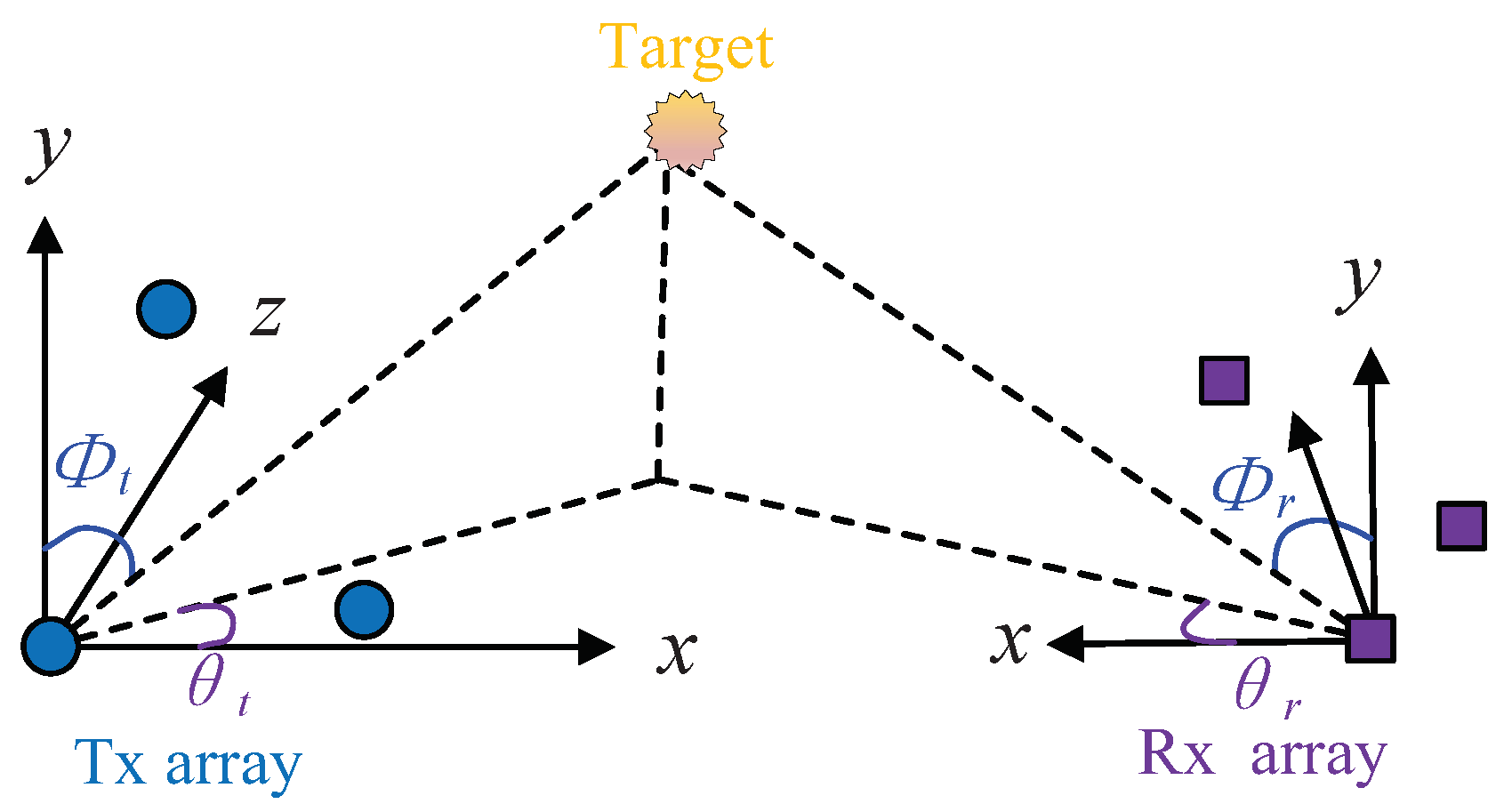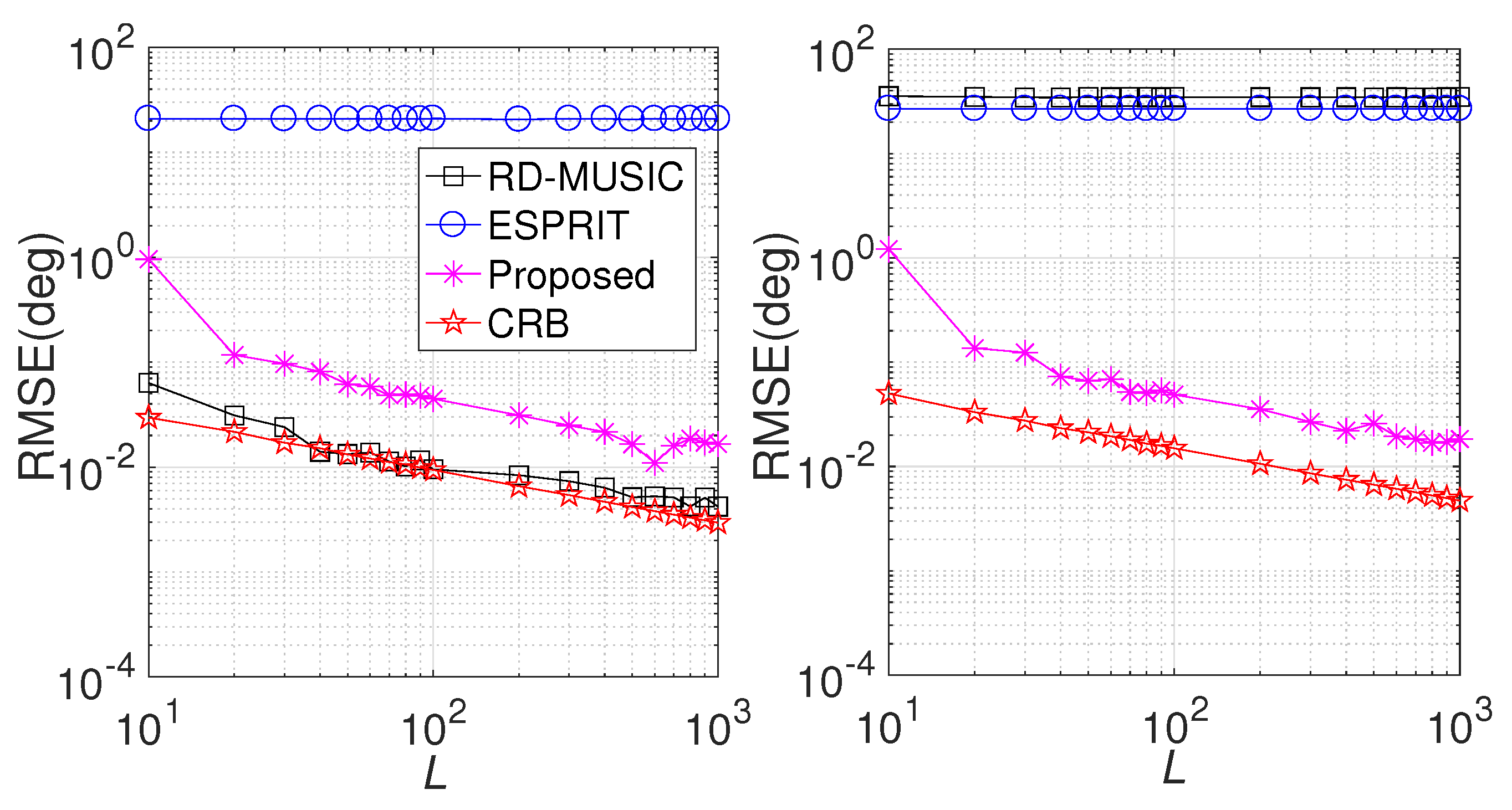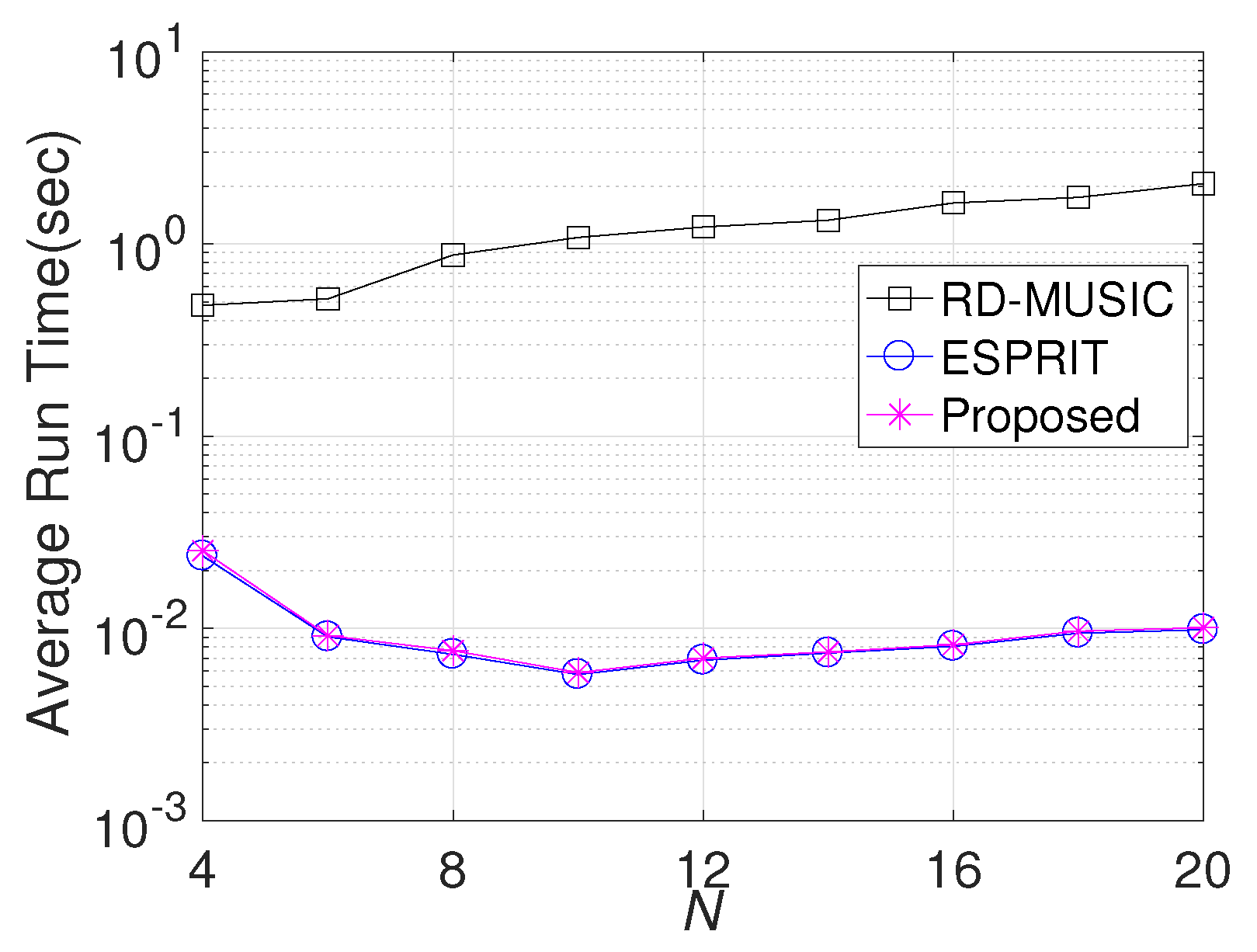Computationally Efficient Direction Finding for Conformal MIMO Radar
Abstract
1. Introduction
2. Signal Model
3. The Proposed Method
3.1. Overview of ESPRIT
3.2. The Proposed Normalized ESPRIT Algorithm
- Step 1. Calculate the covariance matrix () via (12);
- Step 2. Perform eigenvalue decomposition on to obtain the signal subspace ();
- Step 3. Construct the selection matrices ( and ) according to (24), and perform eigenvalue decomposition on to obtain and ;
- Step 4. Calculate the right side of (28b) using to obtain ;
- Step 5. Obtain and via (37), and compensate for the phase using (39);
- Step 6. Compute the right side of (33) and obtain the 2D DOD and 2D DOA via (40).
4. Algorithmic Analyses
4.1. Identifiability
4.2. Complexity
4.3. Cramer–Rao Bounds (CRBs)
5. Simulation Results and Discussion
6. Conclusions
Author Contributions
Funding
Institutional Review Board Statement
Informed Consent Statement
Data Availability Statement
Conflicts of Interest
References
- Ruan, N.; Wang, H.; Wen, F.; Shi, J. DOA Estimation in B5G/6G: Trends and Challenges. Sensors 2022, 22, 5125. [Google Scholar] [CrossRef] [PubMed]
- Cao, R.; Liu, B.; Gao, F.; Zhang, X. A Low-Complex One-Snapshot DOA Estimation Algorithm with Massive ULA. IEEE Commun. Lett. 2017, 21, 1071–1074. [Google Scholar] [CrossRef]
- Tian, Y.; Liu, W.; Xu, H.; Liu, S.; Dong, Z. 2-D DOA Estimation of Incoherently Distributed Sources Considering Gain-Phase Perturbations in Massive MIMO Systems. IEEE Trans. Wirel. Commun. 2022, 21, 1143–1155. [Google Scholar] [CrossRef]
- Li, Q.; Su, T.; Wu, K. Accurate DOA Estimation for Large-Scale Uniform Circular Array Using a Single Snapshot. IEEE Commun. Lett. 2019, 23, 302–305. [Google Scholar] [CrossRef]
- Wen, F.; Liang, C. Improved Tensor-MODE Based Direction-of-Arrival Estimation for Massive MIMO Systems. IEEE Commun. Lett. 2015, 19, 2182–2185. [Google Scholar] [CrossRef]
- Hu, D.; Zhang, Y.; He, L.; Wu, J. Low-Complexity Deep-Learning-Based DOA Estimation for Hybrid Massive MIMO Systems With Uniform Circular Arrays. IEEE Wirel. Commun. Lett. 2020, 9, 83–86. [Google Scholar] [CrossRef]
- Wang, H.; Xu, L.; Yan, Z.; Gulliver, T.A. Low-Complexity MIMO-FBMC Sparse Channel Parameter Estimation for Industrial Big Data Communications. IEEE Trans. Ind. Inform. 2021, 17, 3422–3430. [Google Scholar] [CrossRef]
- Wang, H.; Li, X.; Jhaveri, R.H.; Gadekallu, T.R.; Zhu, M.; Ahanger, T.A.; Khowaja, S.A. Sparse Bayesian learning based channel estimation in FBMC/OQAM industrial IoT networks. Comput. Commun. 2021, 176, 40–45. [Google Scholar] [CrossRef]
- Fan, D.; Gao, F.; Liu, Y.; Deng, Y.; Wang, G.; Zhong, Z.; Nallanathan, A. Angle Domain Channel Estimation in Hybrid Millimeter Wave Massive MIMO Systems. IEEE Trans. Wirel. Commun. 2018, 17, 8165–8179. [Google Scholar] [CrossRef]
- Tang, H.; Wang, J.; He, L. Off-Grid Sparse Bayesian Learning-Based Channel Estimation for MmWave Massive MIMO Uplink. IEEE Wirel. Commun. Lett. 2019, 8, 45–48. [Google Scholar] [CrossRef]
- Zhang, Z.; Shi, J.; Wen, F. Phase Compensation-based 2D-DOA Estimation for EMVS-MIMO Radar. IEEE Trans. Aerosp. Electron. Syst. 2024, 60, 1299–1308. [Google Scholar] [CrossRef]
- Wang, H.; Memon, F.H.; Wang, X.; Li, X.; Zhao, N.; Dev, K. Machine learning-enabled MIMO-FBMC communication channel parameter estimation in IIoT: A distributed CS approach. Digit. Commun. Net. 2023, 9, 306–312. [Google Scholar] [CrossRef]
- Wang, H.; Xiao, P.; Li, X. Channel Parameter Estimation of mmWave MIMO System in Urban Traffic Scene: A Training Channel-Based Method. IEEE Trans. Intell. Transp. Syst. 2024, 25, 754–762. [Google Scholar] [CrossRef]
- Li, J.; Jiang, D.; Zhang, X. DOA Estimation Based on Combined Unitary ESPRIT for Coprime MIMO Radar. IEEE Commun. Lett. 2017, 21, 96–99. [Google Scholar] [CrossRef]
- Zhang, R.; Cheng, L.; Zhang, W.; Guan, X.; Cai, Y.; Wu, W.; Zhang, R. Channel Estimation for Movable-Antenna MIMO Systems Via Tensor Decomposition. IEEE Wirel. Commun. Lett. 2024. [Google Scholar] [CrossRef]
- Zhang, X.; Xu, L.; Xu, L.; Xu, D. Direction of Departure (DOD) and Direction of Arrival (DOA) Estimation in MIMO Radar with Reduced-Dimension MUSIC. IEEE Commun. Lett. 2010, 14, 1161–1163. [Google Scholar] [CrossRef]
- Huang, X.; Liao, B. One-Bit MUSIC. IEEE Signal Process. Lett. 2019, 26, 961–965. [Google Scholar] [CrossRef]
- Bellili, F.; Elguet, C.; Amor, S.B.; Affes, S.; Stéphenne, A. Code-Aided DOA Estimation From Turbo-Coded QAM Transmissions: Analytical CRLBs and Maximum Likelihood Estimator. IEEE Trans. Wirel. Commun. 2017, 16, 2850–2865. [Google Scholar] [CrossRef]
- Zhang, X.; Zheng, Z.; Wang, W.Q.; So, H.C. Joint DOD and DOA Estimation of Coherent Targets for Coprime MIMO Radar. IEEE Trans. Signal Process. 2023, 71, 1408–1420. [Google Scholar] [CrossRef]
- Meng, X.T.; Cao, B.X.; Yan, F.G.; Jin, M.; Zhang, Y. Target Localization for Monostatic MIMO Radar Based on a Double Polynomial Rooting Technique. IEEE Commun. Lett. 2022, 26, 454–457. [Google Scholar] [CrossRef]
- Wen, F.; Shi, J.; Zhang, Z. Joint 2D-DOD, 2D-DOA, and Polarization Angles Estimation for Bistatic EMVS-MIMO Radar via PARAFAC Analysis. IEEE Trans. Veh. Technol. 2020, 69, 1626–1638. [Google Scholar] [CrossRef]
- Shi, J.; Wen, F.; Liu, T. Nested MIMO Radar: Coarrays, Tensor Modeling, and Angle Estimation. IEEE Trans. Aerosp. Electron. Syst. 2021, 57, 573–585. [Google Scholar] [CrossRef]
- Shi, J.; Wen, F.; Liu, Y.; Liu, Z.; Hu, P. Enhanced and Generalized Coprime Array for Direction of Arrival Estimation. IEEE Trans. Aerosp. Electron. Syst. 2023, 59, 1327–1339. [Google Scholar] [CrossRef]
- Wang, X.; Guo, Y.; Wen, F.; He, J.; Truong, T.K. EMVS-MIMO Radar with Sparse Rx Geometry: Tensor Modeling and 2-D Direction Finding. IEEE Trans. Aerosp. Electron. Syst. 2023, 59, 8062–8075. [Google Scholar] [CrossRef]
- Xia, T. Joint diagonalization based 2D-DOD and 2D-DOA estimation for bistatic MIMO radar. Signal Process. 2015, 116, 7–12. [Google Scholar] [CrossRef]
- Serio, A.D.; Hugler, P.; Roos, F.; Waldschmidt, C. 2-D MIMO radar: A method for array performance assessment and design of a planar antenna array. IEEE Trans. Antennas Propag. 2020, 68, 4604–4616. [Google Scholar] [CrossRef]
- Ding, Z.; Xie, J.; Yang, L. Cognitive Conformal Subaperturing FDA-MIMO Radar for Power Allocation Strategy. IEEE Trans. Aerosp. Electron. Syst. 2023, 59, 5072–5083. [Google Scholar] [CrossRef]
- Tian, X.; Chen, H.; Huang, B.; Wang, W.Q. Fast Parameter Estimation Algorithms for Conformal FDA-MIMO Radar. IEEE Sens. J. 2023, 23, 30633–30641. [Google Scholar] [CrossRef]
- Jia, Y.; Wang, W.Q.; Zhang, X.C.; Huang, B. Generalized Ambiguity Function Analysis and Geometry Parameter Optimization for Flexible Conformal Array-MIMO Radar. IEEE Trans. Aerosp. Electron. Syst. 2024, 60, 1334–1350. [Google Scholar] [CrossRef]
- Cao, M.Y.; Vorobyov, S.A.; Hassanien, A. Transmit Array Interpolation for DOA Estimation via Tensor Decomposition in 2-D MIMO Radar. IEEE Trans. Signal Process. 2017, 65, 5225–5239. [Google Scholar] [CrossRef]
- Wen, F.; Zhang, Z.; Sun, H.; Gui, G.; Sari, H.; Adachi, F. 2D-DOA Estimation Auxiliary Localization of Anonymous UAV Using EMVS-MIMO Radar. IEEE Internet Things J. 2024, 11, 16255–16266. [Google Scholar] [CrossRef]
- Wen, F.; Wang, H.; Gui, G.; Sari, H.; Adachi, F. Polarized Intelligent Reflecting Surface Aided 2D-DOA Estimation for NLoS Sources. IEEE Trans. Wirel. Commun. 2024, 23, 8085–8098. [Google Scholar] [CrossRef]
- Li, J.; Zhang, X. Closed-Form Blind 2D-DOD and 2D-DOA Estimation for MIMO Radar with Arbitrary Arrays. Wirel. Pers. Commun. 2013, 69, 175–186. [Google Scholar] [CrossRef]







Disclaimer/Publisher’s Note: The statements, opinions and data contained in all publications are solely those of the individual author(s) and contributor(s) and not of MDPI and/or the editor(s). MDPI and/or the editor(s) disclaim responsibility for any injury to people or property resulting from any ideas, methods, instructions or products referred to in the content. |
© 2024 by the authors. Licensee MDPI, Basel, Switzerland. This article is an open access article distributed under the terms and conditions of the Creative Commons Attribution (CC BY) license (https://creativecommons.org/licenses/by/4.0/).
Share and Cite
Wang, H.; Yu, Z.; Wen, F. Computationally Efficient Direction Finding for Conformal MIMO Radar. Sensors 2024, 24, 6065. https://doi.org/10.3390/s24186065
Wang H, Yu Z, Wen F. Computationally Efficient Direction Finding for Conformal MIMO Radar. Sensors. 2024; 24(18):6065. https://doi.org/10.3390/s24186065
Chicago/Turabian StyleWang, Haochen, Zhiyu Yu, and Fangqing Wen. 2024. "Computationally Efficient Direction Finding for Conformal MIMO Radar" Sensors 24, no. 18: 6065. https://doi.org/10.3390/s24186065
APA StyleWang, H., Yu, Z., & Wen, F. (2024). Computationally Efficient Direction Finding for Conformal MIMO Radar. Sensors, 24(18), 6065. https://doi.org/10.3390/s24186065





